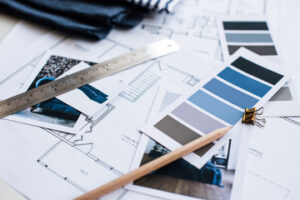Interior Designers use their knowledge of building and construction as well as their skills to plan the design of buildings.

They work to create spaces that are safe, sanitary, and adhere to regulations regarding airflow, heat, extraction, electrical, and plumbing. In addition, they also consider the social context of a space and its occupants’ needs for function, comfort, and aesthetics.
The function of interior designers is to create an aesthetically pleasing and functional space that meets the needs of the people who use it. In order to achieve this, they must be able to take a holistic view of the space and imagine what it could become.
During this process, they will meet with clients to learn more about their needs and desires. This will help them determine their design goals and ensure that they are able to meet them.
Once they have a good idea of what they are trying to accomplish, they will begin to plan the layout and make suggestions about how to arrange furniture and other items to maximize the space in the best way possible. They may also use technology to help them design the space and provide visuals for their clients, such as 3D renderings.
They will work with architects and engineers to ensure that all aspects of the project are well planned. This will include the color scheme, furniture, and other items that will be used in the space.
In addition, they will use their knowledge of the building code and other safety regulations to create a safe and comfortable environment for their clients. They will also coordinate the work of contractors so that they are able to complete the project according to their specifications and standards.
This can be done for a variety of projects, including office buildings, healthcare facilities, hotels, schools, and restaurants. These designs must be functional and meet ADA requirements so that people can live, learn, or work in a safe environment.
Many of these professionals also have a passion for the environment. For instance, they might incorporate energy-efficient materials in their design plans to minimize the amount of electricity needed for operation.
These designers also make sure that the materials they use are environmentally friendly and can be recycled or repurposed in the future. This is a major change in the industry.
The job description for an interior designer varies from client to client and from one location to another, but most are required to be knowledgeable about the building codes and other safety regulations that need to be met in order to have their designs approved. Moreover, they must be able to work under stress in order to meet deadlines and stay within budget.
Interior designers are tasked with enhancing the aesthetics of interior spaces. They do this by combining the right materials, colors, and textures to create a pleasing environment that appeals to their clients.
Aesthetics are the basic principles of design that define a space’s pleasing qualities and include factors such as balance, color, movement, pattern, scale, shape, and visual weight. These aspects of interior design are influenced by the decorative arts and bring out the finest features of different elements in order to create a pleasing effect.
Unlike the visual aesthetics of art, which are subjective, good design aesthetics should be recognizable and easy to understand. They should also have a strong relationship with the main purpose of the design, as they are supposed to be used for a specific function.
For example, the aesthetics of product design should be able to communicate the brand’s personality while also making sure that the products are well-made and environmentally friendly. In addition to functionality, aesthetics are considered important by many consumers, as they can help them determine if a product is worth purchasing.
